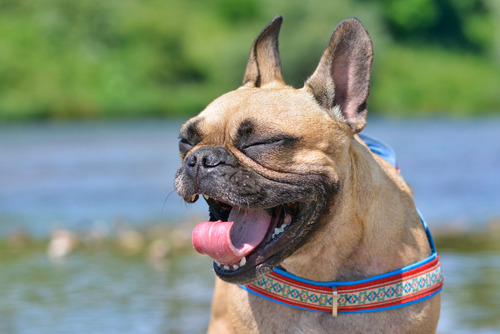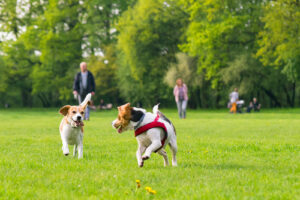If you’ve ever seen your dog suddenly make loud snorting or honking noises, it can be alarming. This common but confusing behavior is known as reverse dog sneezing. Unlike regular sneezing, where air is pushed out, reverse dog sneezing involves rapid inhalations that often make it look like your dog is struggling to breathe. While it can appear dramatic, most episodes are brief and harmless. This blog will help you understand why reverse dog sneezing happens, what triggers it, and when it may signal a need for veterinary attention from the team at Broomfield Veterinary Hospital, so you can feel more confident the next time your dog has an episode.
What is Reverse Dog Sneezing?
Reverse dog sneezing is a respiratory reflex where dogs rapidly inhale through their nose, creating a distinctive snorting or honking sound. During an episode, your dog may stand still, extend their neck, and flare their chest while repeatedly pulling air inward. The sound can be startling, often leading pet owners to believe their dog is choking.
How it Differs from Regular Sneezing
- Regular sneezing: Air is forcefully expelled outward.
- Reverse sneezing: Air is sucked inward through the nasal passages.
Because reverse dog sneezing looks unusual, many pet owners mistake it for something more serious. However, in most cases, it is simply a reflex to clear the nasal passages of irritation.
What Causes Reverse Dog Sneezing?
There isn’t a single cause of reverse dog sneezing, but several factors can trigger episodes:
- Nasal irritants such as pollen, dust, or strong scents
- Allergies that cause airway sensitivity
- Excitement or overexertion
- Temperature changes or inhaling cold air
- Pulling on the leash or collar that irritates the throat
- Anatomical traits in breeds with short snouts (brachycephalic dogs)
Breed Susceptibility
Some breeds experience reverse sneezing more frequently. Small dogs and brachycephalic breeds such as Pugs, Bulldogs, and Shih Tzus are more prone due to narrower nasal passages and elongated soft palates.
What Does Reverse Dog Sneezing Look and Sound Like?
When reverse dog sneezing occurs, the symptoms are hard to miss. Episodes usually last anywhere from a few seconds to a minute.
Typical Signs
- Loud snorting or honking noises
- Standing still with an extended neck
- Chest expanding rapidly with each inhale
- Gasping appearance, as if trying to catch their breath
Key Points for Pet Owners
- Episodes usually resolve on their own.
- Dogs remain alert and do not lose consciousness.
- After the episode, most dogs return to normal immediately.
Because reverse sneezing can mimic signs of choking, asthma, or collapsing trachea, it’s understandable why owners often worry.
How is Reverse Dog Sneezing Diagnosed?
Since reverse sneezing can resemble other respiratory issues, veterinarians typically diagnose it through observation and by ruling out more serious conditions.
What Your Veterinarian May Consider
- Health history: Frequency and duration of episodes.
- Physical exam: Checking nasal passages, throat, and airway.
- Possible tests: If symptoms suggest an underlying condition such as allergies, infection, or airway obstruction.
At Broomfield Veterinary Hospital, our team helps pet owners understand whether their dog’s sneezing fits are simply reverse sneezing or if another condition needs attention. If you’re concerned about frequent or severe episodes, call 303-466-1764 or book an appointment online today.
Is Reverse Sneezing Dangerous?
For most dogs, reverse sneezing is not dangerous. Episodes may look alarming but are usually harmless and self-limiting. However, it’s still important to understand when it might point to something more serious.
When to Seek Veterinary Attention
- Episodes are very frequent or last longer than a minute.
- Your dog shows additional symptoms like coughing, nasal discharge, or lethargy.
- Your dog struggles to recover after an episode.
- You notice changes in breathing between episodes.
In rare cases, frequent reverse dog sneezing may indicate allergies, respiratory infections, or structural issues in the nasal passages or throat.
How to Help Your Dog During an Episode
While reverse dog sneezing episodes usually resolve on their own, pet owners often want to know how to make their dog more comfortable.
Staying Calm
Dogs often pick up on your stress. Remaining calm can help your pet settle more quickly.
Gentle Actions That May Help
- Offer a calm, quiet environment.
- Avoid pulling on the leash or collar during an episode.
- Monitor the duration and frequency to share with your veterinarian.
Remember that reverse sneezing typically doesn’t require intervention, but documenting patterns can help your veterinarian identify possible triggers.
Can Reverse Dog Sneezing Be Prevented?
While you can’t completely prevent reverse dog sneezing, you may be able to reduce how often it occurs by minimizing potential triggers.
Environmental Adjustments
- Keep your home free of dust and strong odors.
- Use air filters to reduce allergens.
- Limit exposure to heavy perfumes or cleaning chemicals.
Lifestyle Considerations
- Walk your dog with a harness instead of a collar to reduce throat irritation.
- Keep track of whether exercise, excitement, or seasonal changes increase episodes.
By paying attention to patterns, you can help your veterinarian pinpoint what may be causing your dog’s reverse sneezing.
Reverse Sneezing vs. Other Respiratory Conditions
Because reverse sneezing looks dramatic, it’s often mistaken for more serious health concerns. Knowing the differences can help you communicate clearly with your veterinarian.
Conditions That May Resemble Reverse Dog Sneezing
- Collapsing trachea: More common in small breeds; involves a honking cough.
- Kennel cough: A dry, hacking cough often spread in social settings.
- Asthma: Causes wheezing and labored breathing.
- Choking: Immediate distress and possible pawing at the mouth.
If you ever feel unsure whether your dog is experiencing reverse sneezing or another condition, it’s always best to reach out to your veterinarian.
Supporting Your Dog’s Health in Broomfield, CO
Reverse dog sneezing may be startling, but for most dogs, it’s nothing to fear. By learning what triggers episodes and monitoring their frequency, you can support your dog’s comfort and overall well-being. If you notice frequent episodes or changes in your pet’s breathing, the team at Broomfield Veterinary Hospital can help. Call us at 303-466-1764 or book an appointment online today to discuss your dog’s symptoms and get peace of mind about their health.





